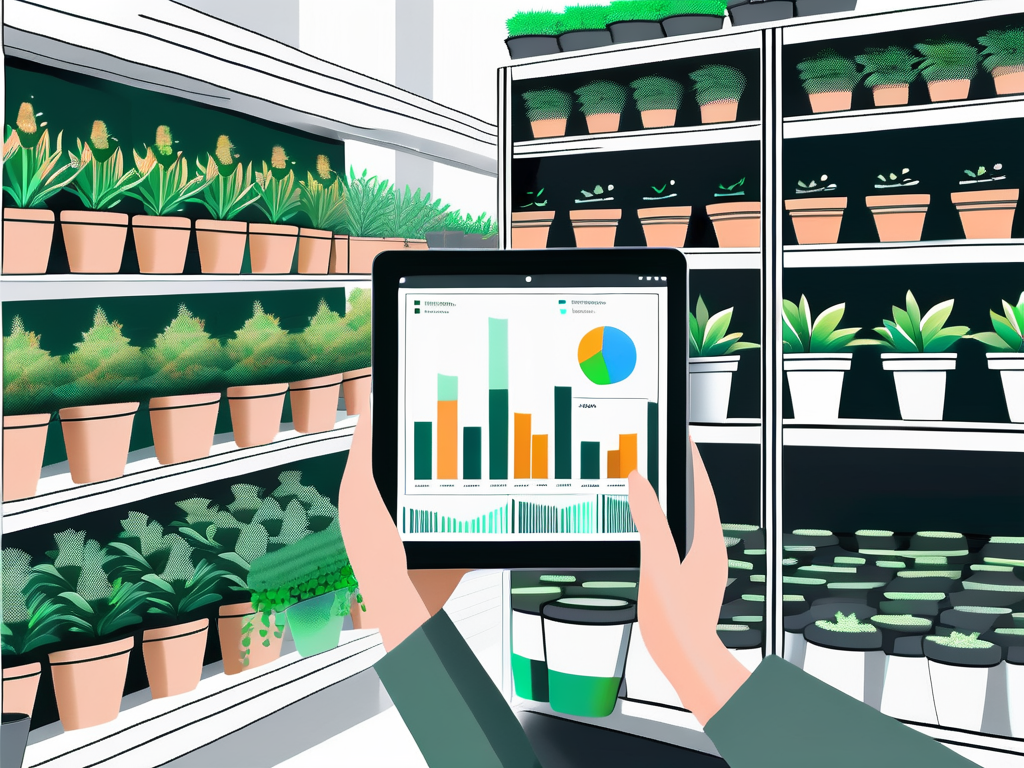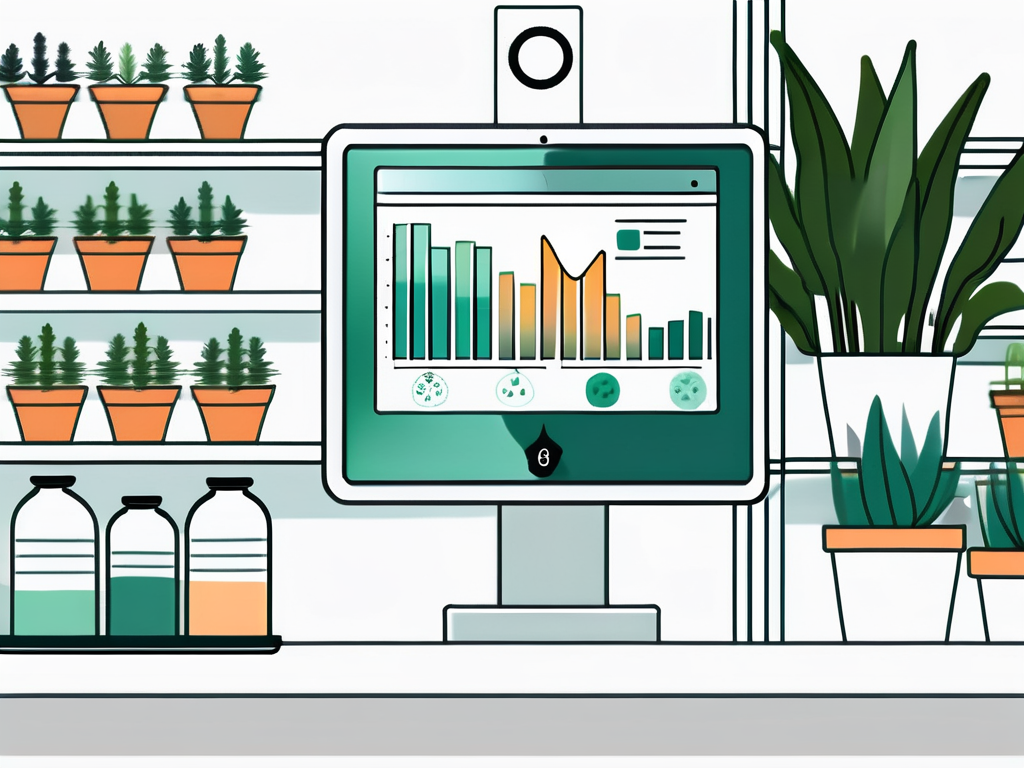
If you own or operate a plant nursery, optimizing your inventory management is crucial to running a successful and profitable business. Efficient inventory management not only ensures that you have the right plants and products available when customers need them but also helps prevent overstocking and reduces unnecessary expenses. In this comprehensive guide, we will explore the basics of nursery inventory management, steps to optimize your inventory, leveraging technology, strategies for reducing costs, and training your staff for effective inventory management.
Understanding the Basics of Nursery Inventory Management
The Importance of Efficient Inventory Management
Efficient inventory management is the backbone of any successful plant nursery. It allows you to meet customer demand, minimize stockouts, and reduce excess inventory. By effectively managing your inventory, you can streamline operations, improve customer satisfaction, and increase the overall profitability of your nursery.
Key Components of Nursery Inventory Management
Successful nursery inventory management requires attention to several key components. These include accurate tracking of inventory levels, regular inventory audits, keeping updated records, and a reliable system for managing stock. Adopting these practices will ensure that you have the right plants and products available at all times, reducing wastage and improving customer satisfaction.
Accurate tracking of inventory levels is crucial for a plant nursery as it helps in understanding which products are in demand and which ones are slow-moving. By analyzing this data, nursery owners can make informed decisions about purchasing new inventory, promoting certain products, or discontinuing items that are not selling well. Regular inventory audits play a vital role in maintaining the accuracy of inventory records. Conducting physical counts of plants and products on a regular basis helps in identifying discrepancies and addressing them promptly.
Keeping updated records is essential for nursery inventory management as it provides a clear picture of the current stock levels, sales trends, and overall performance. Utilizing inventory management software can streamline this process by automating tasks such as reordering, tracking sales, and generating reports. A reliable system for managing stock ensures that plants are stored properly, labeled correctly, and easily accessible for staff. Implementing efficient shelving systems, storage solutions, and barcode technology can further enhance the organization and efficiency of inventory management in a plant nursery.
Steps to Optimize Your Plant Nursery Inventory
Conduct an Inventory Audit
Begin by conducting a thorough inventory audit to assess the current state of your stock. This involves physically counting and recording the quantity of each item in your inventory. The audit will provide you with accurate data to identify any discrepancies between recorded inventory levels and actual stock on hand. It’s crucial to pay attention to details during the audit process, ensuring that every plant, pot, and gardening tool is accounted for.
Implementing a Reliable Tracking System
Once you have completed the inventory audit, it’s time to implement a reliable tracking system. This could include barcode scanning, RFID tags, or other technology solutions to keep track of inventory movement accurately. By using a tracking system, you can minimize the risk of human error and easily monitor stock levels. Additionally, consider categorizing your inventory based on plant types, sizes, or seasonal availability to streamline the tracking process further.
Regularly Updating Your Inventory Records
Keeping inventory records up to date is essential for effective inventory management. Regularly update your records with new stock additions, sales, and any other stock movement. This will provide you with an accurate overview of your inventory levels and help you make informed decisions regarding purchasing and sales to optimize stock levels. Consider conducting spot checks periodically to ensure the accuracy of your records and address any discrepancies promptly.
Investing in a Cloud-Based Inventory Management System
Consider investing in a cloud-based inventory management system to streamline your inventory control processes further. These systems offer real-time tracking, automated alerts for low stock levels, and data analytics to help you forecast demand accurately. By leveraging technology, you can enhance efficiency in managing your plant nursery inventory and focus more on providing excellent customer service and expanding your product offerings.
Leveraging Technology in Inventory Management
Benefits of Using Inventory Management Software
Implementing inventory management software can revolutionize your nursery’s inventory management processes. With software, you can automate tasks such as stock tracking, reordering, and generating reports. This streamlines your operations, saves time, reduces errors, and enables you to make data-driven decisions.
Choosing the Right Technology for Your Nursery
When selecting inventory management technology for your nursery, consider factors such as scalability, integration with other systems, ease of use, and cost. Assess different software options available in the market and choose a solution that best suits the unique needs and size of your nursery.
Integration with E-commerce Platforms
One key aspect to consider when leveraging technology in inventory management is the integration of your inventory management software with e-commerce platforms. By seamlessly connecting your inventory system with your online store, you can ensure real-time updates on product availability, prevent overselling, and improve customer satisfaction. This integration also allows for better synchronization of data across all your sales channels, providing a unified view of your inventory.
Utilizing Data Analytics for Forecasting
Another advantage of utilizing technology in inventory management is the ability to leverage data analytics for forecasting and demand planning. By analyzing historical sales data, seasonal trends, and market insights, you can optimize your inventory levels, reduce stockouts, and minimize excess inventory. Data-driven forecasting enables you to anticipate customer demand more accurately, leading to improved inventory turnover and profitability for your nursery.
Strategies for Reducing Inventory Costs
Implementing Just-in-Time Inventory
One effective strategy for reducing inventory costs is implementing a just-in-time inventory approach. This means ordering inventory only when it is needed just in time for customer demand. By minimizing excess stock, you can reduce carrying costs, minimize waste, and optimize cash flow.
Reducing Waste and Shrinkage
Waste and shrinkage can significantly impact your nursery’s profitability. Implement practices such as regularly inspecting stock, minimizing overstocking, and ensuring proper storage conditions. Additionally, train your staff on awareness and prevention measures to reduce waste and shrinkage, ultimately cutting unnecessary expenses.
Implementing Technology Solutions
Integrating technology solutions like inventory management software can streamline your inventory processes, providing real-time data on stock levels, sales trends, and supplier information. This data can help you make informed decisions, avoid stockouts, and reduce the risk of overstocking. Furthermore, automated systems can help track expiration dates, leading to a reduction in waste and spoilage.
Collaborating with Suppliers
Developing strong partnerships with your suppliers can lead to cost-saving opportunities. By sharing sales data and forecasts with your suppliers, you can work together to implement vendor-managed inventory systems or negotiate better pricing based on volume commitments. Additionally, collaborating on product design and packaging can help reduce transportation costs and improve efficiency in the supply chain.
Training Staff for Effective Inventory Management
Importance of Staff Training in Inventory Management
Training your staff is critical to maintaining efficient inventory management practices. Your employees need to understand the importance of accurate stock records, tracking inventory movement, and following proper procedures. Well-trained staff will contribute to more effective inventory management, reducing errors and improving overall operations.
It is important to note that investing in staff training not only benefits your inventory management processes but also enhances employee morale and job satisfaction. When employees feel confident in their roles and understand the significance of their contributions to inventory control, they are more likely to be engaged and motivated in their work.
Best Practices for Training Your Staff
When training your staff, provide clear instructions on how to handle stock, use the tracking system correctly, and communicate any inventory-related issues. Consider regular refresher training sessions to reinforce good practices and keep your employees up to date with changes in inventory management procedures.
Moreover, fostering a culture of continuous learning within your organization can lead to innovation and improved efficiency in inventory management. Encouraging employees to share their insights and suggestions for process improvement can result in tailored solutions that address specific inventory challenges faced by your plant nursery.
In conclusion, optimizing plant nursery inventory management is essential for running a successful and profitable business. By understanding the basics, implementing key steps to optimize your inventory, leveraging technology, reducing costs, and training your staff effectively, you can ensure that your nursery operates smoothly, meets customer demand, and maximizes profitability. Implement these practices, stay proactive, and continuously monitor and adjust your inventory management processes to stay ahead in a competitive market.







